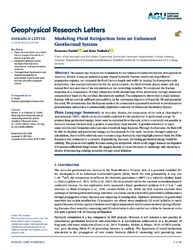Modeling Fluid Reinjection Into an Enhanced Geothermal System
DOI: https://doi.org/10.1029/2020GL089886
Persistent URL: http://resolver.sub.uni-goettingen.de/purl?gldocs-11858/8806
Persistent URL: http://resolver.sub.uni-goettingen.de/purl?gldocs-11858/8806
Parisio, Francesco; Yoshioka, Keita, 2020: Modeling Fluid Reinjection Into an Enhanced Geothermal System. In: Geophysical Research Letters, Band 47, 19, DOI: 10.1029/2020GL089886.
 |
Dokument öffnen: |
Abstract
The manuscript analyzes the stimulation for an Enhanced Geothermal System development in Acoculco, Mexico. Using an analytical penny-shaped hydraulic fracture model covering different propagation regimes, we computed the final fracture length and width by varying fluid properties with temperature. Our analysis indicates that for the given scenario, the fluid viscosity plays a minor role and instead flow rate and time of the stimulation are the controlling variables. We computed the fracture reopening as a consequence of water reinjection in the second stage of the stimulation through numerical computations based on the enriched discontinuity method. The computation shows that a single isolated fracture will not provide sufficient permeability, as the continuous injection will quickly fill and pressurize the crack. We demonstrate that the fracture needs to be connected to a permeable network to avoid excessive pressurization and achieve a commercially exploitable reservoir for Enhanced Geothermal System.
Statistik:
ZugriffsstatistikSammlung:
This is an open access article under the terms of the Creative Commons Attribution License, which permits use, distribution and reproduction in any medium, provided the original work is properly cited.

